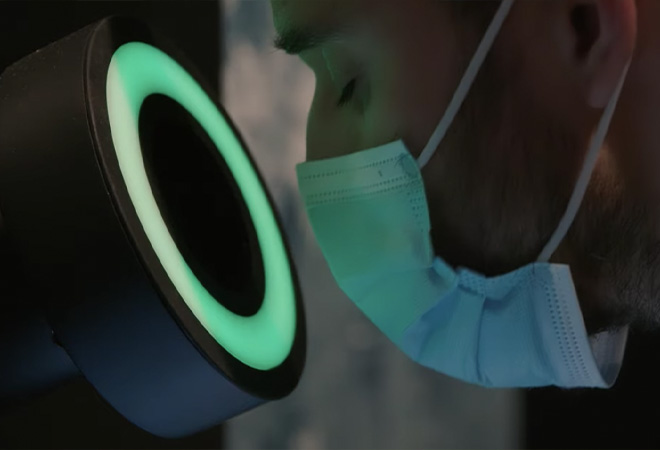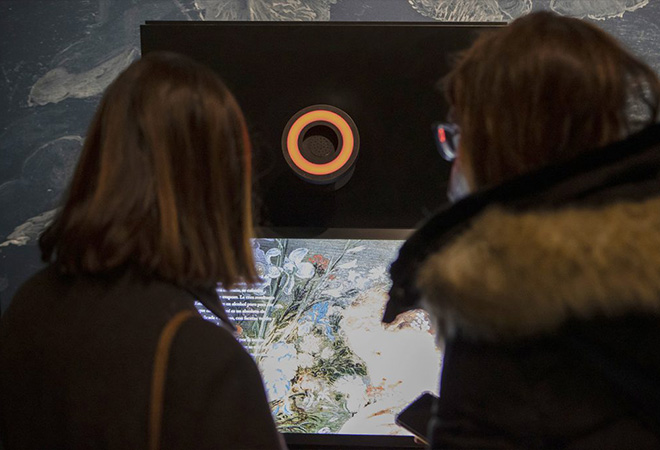Scent in the art exhibition space, while at first glance not seeming like the most obvious choice—there’s potential allergens and ventilation issues to contend with, not to mention diffusion challenges to contend with—is an intriguing multisensorial approach to connecting consumers with scent.
The latest of such endeavors is “The Essence of a Painting. An Olfactory Exhibition” by the Museo Del Prado in Madrid. Curated by Gregorio Sola, Senior Perfumer at Puig and an academician of the Perfume Academy, and Alejandro Vergara, Chief Curator of Flemish Painting and the Northern Schools at the Museo del Prado, the installation is built around a single painting: “The Sense of Smell” (1617-1618) by Jan Brueghel and Peter Paul Rubens.
Inspired by the more than 80 species of flora and additional elements (from animals to vessels) present in the piece, Sola created 10 distinct fragrances, which visitors can experience through a Samsung touchscreen tablet that incorporates Puig’s patented AirParfum technology in four embedded diffusers. The unique scent application disperses aromatic molecules devoid of alcohol, which have been extensively tested to ensure allergy and health safety. Alcohol-free components, which due to their small size don’t increase the room humidity, also are ideal for avoiding potential damage to the fragile artworks in the space. Furthermore, given the fleeting and lightweight nature of the emitted scents, viewers are able to experience the curated selection of olfactory artworks without sensorial overwhelm or exhaustion.
As for the scents in question, there are three traditional perfume compositions (Allegory, Gloves, Fig Tree) and seven single-note concoctions (Orange Blossom, Jasmine, Iris, Rose, Daffodil, Civet, Spikenard). Allegory represents the bouquet of flowers held by the painting’s protagonist and contains notes of rose, jasmine, and carnation. Gloves is an ode to the perfumed gloves worn in 17th-century Europe to mask body odor—a reproduction of an amber-scented glove recipe from 1696 to be exact—with facets of suede, resins, balms, woody notes, and flower essences. Fig Tree contains green and woody notes to allude to the scent of growing botany on a warm summer day. Even the single-note fragrances display complexity: for the Rose fragrance, Sola combined the centifolia and damascena roses, incorporating the former’s more honey-like qualities and the latter’s fruitier facets. Naturally, the procurement of such materials has evolved throughout history. The Civet used in the exhibition is a synthetic, whereas the material was originally derived from the sack of the African civet cat.
BeautyMatter spoke to Sola about the challenges of creating fragrance for public spaces, historically accurate perfumery, and the future of scent engagement for consumer audiences.


What is the relationship between scent and art?
Gregorio Sola: For me, perfumery is an art itself. In the '60s, a perfumer called Edmond Roudnitska said that perfumery is an art and it's between sculpture and music. It's like music because as perfumers we speak about notes, accords, and composition, and when we describe a perfume we can give them shapes. It can be a square, round, velvety, sharp, or metallic. Here we merged two arts: painting and perfume. Research has shown that you remember something better if you are smelling at the same time as seeing, so it's a good idea to combine the two.
Art itself can have that emotional connection, but adding a scent element to it makes it even more profound. Speaking about painting, the artwork had 80 different species of plants in it. How did you pare it down to these 10 scents?
We tried to link the perfume and raw materials of today with ancient perfumery of the past. We cannot kill civet cats for the oil, so in this case we use the synthetic. For Spikenard, which is an herb from the Himalayas, we used tuberose from Mexico because spikenard is not used in perfumery today.
We chose 10 fragrances so people can spend a quantity of time with the fragrances without there being a long queue of people lining up waiting to experience the smell. If we put only five it is too short, if we put 20 it's too long. Finally, we decided we would try to be as academic as possible, and it's for that reason that all the ingredients have a strong research background.
In some cases, you have the straight note. In the case of Orange Flower, you can use distilled neroli or absolute fleur d'oranger. We tested both notes separately and mixed them in different proportions. We found that it's better to increase neroli because it's cleaner, more fresh than the absolute, but we want to have this honey side from the absolute. For Rose, we mixed centifolia and damascena rose to have the perfect balance between the freshness of the centifolia and this green, somewhat dark note in the damascena rose. In the case of narcissus, daffodil is the best quality interpretation you can get today.
On the other hand, you have Allegory, Glove, and Fig Tree. The most difficult one has been the most simple one: Allegory. It contains just rose, jasmine, and carnation. It's like when you cook miso soup: there are few ingredients, but to find the balance is really complicated. When you have a huge number of ingredients in the composition, you can balance it easier.
There's also a confidence in having less. In The Perfect Scent, Chandler Burr wrote about Jean-Claude Ellena making Un Jardin Sur Le Nil for Hermès, and he said something along the lines of there's less space to hide when you have less ingredients.
There are some perfumes that can have 300 ingredients. It's complicated to weigh, for the factories to produce, complicated for everyone. But a perfume with that number of ingredients came from the '60s or the '70s. Nowadays we use between 20 and 80 at maximum. When you use fewer ingredients, it's more complicated but it's a nice feeling at the end when you reach the point of balance.
That feeling can be so individual, right? We all smell differently. We also have different emotional connections to certain smells. So what are those challenges when you're creating a scent for a public space?
One of the problems that we had, in the example of Rose, is the mix of only centifolia oil and damascena rose was so pure, but this mix doesn't smell like a rose you can find in a perfume, which is softer and cleaner. The natural rose has imperfections and people are not used to this imperfection.
When you are working for public space, normally when people go shopping for perfume, they cannot smell more than three or four fragrances at a time. This diffusion system that we have doesn’t contain alcohol and it allows you to smell the 10 perfumes easily. What makes perfumery amazing is that a perfume is like a diamond: with different facets. Everyone has a different reaction, which is what you have to take into account.
What is also nice about AirParfum is it doesn't saturate the entire room and it doesn’t change the profile of the original scent. When you test fragrances, normally they use a paper blotter or other material in order to test the fragrance, but that changes the evaporation and smell of the original perfume.
What was the process of putting the exhibition together like?
It was a dream. I could never imagine being at the Prado Museum, and the collaboration with Alejandro was amazing, how much he knows about the history of painting and how that translated into making a better perfume for this project. We had a lot of work going on backstage, finding a fragrance formula for the ambery glove in books from 15th- and 16th- century France. The research has to be really strong if you are presenting this information to the public.
How was it finding that middle ground in changing scent tastes? What people appreciated in the 17th century versus now? Was it more important to be historically accurate or more user friendly?
The scents were stronger in the 17th century because people didn’t have the same level of hygiene back then. Today, you have a baseline that is already clean and the perfume is something you put over it, rather than using it to mask bad body odors. On the other hand, ingredients are completely different now because of modern chemistry. Back then, they had a lower quantity of ingredients in the palette. When you look at books from that era, almost all of the fragrance formulas contain civet, which smells really strong and animalic, but it also had a fixative power, so they dressed this odor up with what they had at hand. Today, in some cases, a strong odor is perceived as aggressive by some, but others prefer it.
Obviously there's a very small subset of people that can have an allergic reaction to fragrance. Is there any kind of thought around allergen potential that you have to be aware of with a project like this?
All the natural ingredients contain allergens by themself, but all the ingredients we put inside the perfume have been tested in terms of toxicology and dermatology. You can have an allergic reaction but it is really, really, really low. I was really afraid of having a problem with that, but also the diffusion system gives you a low dose of aromatic molecules which you do not touch, only smell. On the other hand, we have taken care to make a formulation which avoids these kinds of problems. You cannot assure 100% safety, only 99.99%.
You want it to be an unforgettable experience, but for the right reasons.
When you see people enjoying the exhibition, what is most satisfying is that it's a collective experience. In some cases, there is a lot of noise in the museum because everyone is expressing their opinions and emotions about what they are smelling.
What has the reception to this project been like?
In the first two weeks, between 10,000 and 15,000 people visited the exhibition—this is an amazing success for us.
There's a real kind of hunger for these types of scent experiences. What effect is bringing it into art institutions having on consumers?
They perceive the museum in a different way. Your memory of the experience is stronger. People have a curiosity and want to have novelty. This innovation nourishes that curiosity.
Do you think these multisensory approaches could be the future of art exhibitions?
Yes, I would like it to be because I love scent and think that people do not realize how important it is to the human being. You can translate a lot of these ambiences and ideas in different ways.
“The Essence of a Painting. An Olfactory Exhibition” is on display at the Museo Nacional del Prado until July 3, 2022.

Want to continue reading this article and others just like it?
Subscribe to BeautyMatter and access the most current beauty intelligence and news updates.
SubscribeAlready a member, login here.